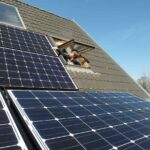Energy News Beat
Xcel Energy is dedicating a bigger share of its Minnesota solar incentives to lower-income customers in response to a new state law.
Since launching in 2014, Solar Rewards has provided financial incentives to help thousands of Minnesota homeowners pay for small solar installations. Over the past five years, state lawmakers, regulators, and the utility have gradually directed a larger share of Solar Rewards to income-qualified customers.
The new state law increases that amount to 50% of the program’s budget, up from a 30% expectation in the previous year. The tradeoff is that the program will fund fewer projects overall, as low-income customers get a larger incentive, much of it upfront, in order to help cover installation costs.
While some solar companies have expressed concern that the money won’t go as far, others are happy about the increased commitment to low-income customers.
“Now that those incentives have been increased, organizations like ourselves can go ahead and sign up a lot more of these types of income-qualified participants,” said Pouya Najmaie, policy and regulatory director for Cooperative Energy Futures, a Twin Cities solar developer that focuses on lower-income customers.
Get connected
Every morning, thousands of energy professionals turn to our newsletters for the day’s most important news. Sign up for free to get the latest delivered straight to your inbox.
Xcel Energy and solar developers have generally exceeded Solar Rewards’ low-income targets by recruiting commercial and multi tenant housing clients. In a statement to the Energy News Network, the utility said allotting half the budget for income-qualified participants “is a large jump.”
Xcel conceded that reaching homeowners and renters has been difficult but said it will be less so with the new, higher incentives. “The number of income-qualified residential customers grows each year, and the increase will ensure there are plenty of incentive dollars available for communities that need better access to renewable energy and solar,” the company said.
Solar Rewards is funded by the state’s Renewable Development Account, a fund that Xcel pays into in exchange for storing nuclear waste at its two nuclear power plants. The program’s budget fluctuates from $5 million to $10 million annually. It’s helped pay for more than 6,700 projects, mainly for middle- and higher-income residential customers.
Incentives are limited to 40 kilowatt and smaller projects. Typically, solar developers help enroll clients into the Solar Rewards program and use the subsidies as a selling point. Customers who participate, including income-qualified, receive a ten-year bonus payment for unused electricity they generate and send back onto the grid.
In 2019, Solar Rewards began allocating a minimum of 10% and a maximum of 20% of the annual budget to income-qualified participants, a category that includes single-family homeowners, multifamily buildings, nonprofits, schools, and community solar gardens. In 2022, the program increased the income-qualified portion to 30% and expanded access to renters.
For the fourth quarter of this year and all of next year, the Legislature required 30% of the budget to go to residential customers, including renters, while 20% goes to other income-qualifying participants, for a total of half the budget.
As of September, Xcel had spent 59% of the Solar Rewards income-qualified budget, though a breakdown between residential and other customers was not available. A Commerce Department analysis saw that as a good sign, suggesting “participation is progressing well considering significant mid-year funding changes.”
State Rep. Patty Acomb last session chaired the House Climate and Energy Finance and Policy Committee, where the legislation originated. She said the Legislature wanted to make sure the program is benefitting those customers and not just nonprofits, schools, and other institutional customers.
“You don’t see as many people in the low- and moderate-income categories that have participated, so we’re doing what we can to incentivize and to extend that opportunity,” Acomb said.
Legislators also believed that changing Solar Rewards allows income-qualified applicants to take advantage of the 30% tax credit and other federal incentives in the Inflation Reduction Act, she said.
The increased income-qualified budget should assist single-family homeowners, multifamily owners, and tenants interested in reducing utility bills.
“We certainly heard from the development community that there was a need there,” Acomb said. “We’re hearing from developers that we need more money in Solar Rewards and certainly not less.”
Minnesota Solar Energy Industries Association executive director Logan O’Grady said Solar Rewards has been around long enough to have reached many early adopters and moderate-income customers. Incentives have changed over the years, sometimes declining to spread the money to a wider group. The legislation “will refocus” the industry on the lower-income market.
“I think (incentives) are going to be really important for helping push those that are on the fence about solar right now to over the fence, with more people deciding ‘I’m going to invest in this,’” O’Grady said. “The challenge now is reaching those underserved communities.”
Bobby King, executive director of Solar United Neighbors’ Minnesota office, agrees. His nonprofit saves money by bulk buying, or hiring contractors to buy panels and install at the homes of many customers living in a city or a neighborhood. Solar Rewards previously has not offered enough incentive for people living paycheck to paycheck to invest in solar, he said, causing some homeowners to drop out after seeing the price tag.
The new incentive structure will allow Solar United Neighbors to recruit more income-qualified households to its group buying program, King said. The incentive now provides income-qualified customers enough money to pay for as much as two-thirds of the cost of the panels and installations, which is a better deal than the program previously offered.
“I’m pleasantly surprised at how it’s moving pretty robustly in the right direction,” King said.
Qualifying buyers under the old Solar Rewards rules also limited applicants to those receiving Energy Assistance. Xcel agreed to expand eligibility requirements to include people on medical assistance or involved in other government programs, King said. The broader the income-qualified buyer pool, the more likely the Solar Rewards budget will meet the 50% goal.
Michael Allen, chief executive officer of All Energy Solar, likes Solar Rewards but advocates for smaller incentives to spread the money more widely. He questions giving substantially more money to income-qualified customers because it cuts into the budget for subsidizing other homeowners.
Smaller incentive packages allow developers to sign up more customers and will result in more solar being installed, he said. Giving significant subsidies to fewer people does the opposite, Allen said.
Reaching income-qualified customers remains challenging. Many of them initially have little knowledge or interest in solar, and identifying which customers are income-qualified can be difficult. Allen suggested that the fastest way to get income-qualified customers the benefits of solar would be to help them enroll in community solar gardens.
Another approach would be to allow for more third-party ownership of solar installations in disadvantaged neighborhoods, a technique that Cooperative Energy Futures and a handful of other developers have used.
Allen, however, said the state’s public utility regulations only allow third-party solar owners to fund around two dozen projects without coming under Public Utilities Commission regulation. Permitting third-party owners to develop more projects could deliver more income-qualified solar projects in Minnesota, he said.
“I’m not discouraging low- to moderate-income solar,” Allen said. “I’m just saying that we haven’t figured out the recipe yet.”
Related
The post Minnesota adjusts solar incentives to prioritize low-income households appeared first on Energy News Beat.








